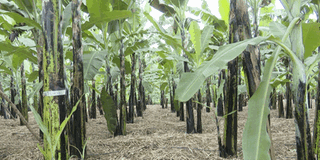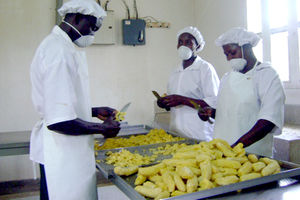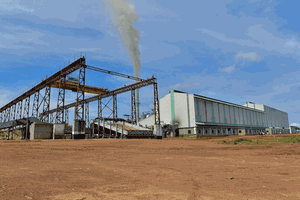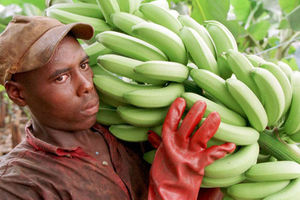
After installing machinery to mass-produce value-added goods on a much larger scale from bananas as the key raw material in Sanga, Kiruhura District, Western Uganda, currently projected to be commissioned in 2027. PHOTO/ Collins Muhwezi
When Finance Minister Matia Kasaija disclosed in the financial year 2024/2025 budget speech that an additional Shs50 billion would be availed to complete the Presidential Initiative on Banana Industrial Development (PIBID) capitalisation, there was an uproar among Members of Parliament (MPs) in a sitting held at Kololo Independence Grounds in mid-June.
This state of commotion was right in the conspicuous presence of President Museveni whose Shs72 trillion budget was being read.
Irrespective of the displeasure expressed by the MPs, the government commits to support PIBID which has metamorphosed into the Banana Industrial Research and Development Centre (BIRDC), in establishing a semi-automated plant in Bushenyi with a daily processing capacity of 14 metric tons of fresh matooke.
The continuous support for this initiative is on the basis that it has shown potential for import substitution by replacing wheat while providing gluten-free starch products whose global demand is on the rise.
With the support to transition into a self-sustaining business, PIBID or BIRDC, will be in position to fulfill international orders from South Korea, the Royal Kingdom of Saudi Arabia, Qatar, and Italy, all of which can’t wait to receive their orders.
However, at least 40 percent of banana harvest gets wasted before reaching the market, according to the Agriculture Ministry.
The government is now banking on value addition and import substitution to catalyse and expand the size of Uganda’s economy from about $50 billion currently, to $500 billion by 2040.
This presidential initiative commits to improving the competitiveness of agricultural products such as bananas in both regional and international markets. But why are legislators unhappy with the initiative?
Clueless
In an interview at Bushenyi-based facility, the Director General of BIRDC formerly known as PIBID, Professor Florence Isabirye Muranga, seems puzzled by the cold reception she receives from some MPs.

Professor Florence Isabirye Muranga, the Director General of the Banana Industrial Research and Development Centre. PHOTO/COLLINS MUHWEZI
The food scientist, who thrice rejected an invitation by President Museveni to set up and head the banana processing incubation in the country before reconsidering her position to take up the offer two decades ago, says her main focus is to ensure that Uganda’s bananas are processed into multiple value-added products just like wheat or potatoes.
“I know the potential of what we are doing – it is like a goldmine. Many other countries would want it, but I decided to do it here at home,” she says. But it wasn’t without conditions.
First, she needed assurance that the funding for her role as head of the incubation and the subsequent development resulting from her work would be well allocated.
Secondly, she wanted Mr Museveni to take up the patron’s role. She got both demands.
Close to Shs200 billion has been injected into the initiative over the last two decades. While President Museveni took up the patron’s role, the funding support kept coming in billions. As a result, she didn’t have to worry about funding constraints freeing her to concentrate on her core expertise – research and development.
With the incubation up and running in Bushenyi, in western Uganda, there are already good signs of product development explaining the acquisition of new land in Sanga in Kiruhura District where the banana products’ value addition is set to be commercially produced.
After installing machinery to mass-produce value-added goods on a much larger scale from banana as the key raw material in Sanga, Kiruhura District, Western Uganda, currently projected to be commissioned in 2027 – barely three years away from now, up to 500 kilogrammes of banana per day will be processed by a single drier, a technology used process and preserve food safely.

Matooke in Kalerwe Market. Uganda is among the top 10 leading banana producers in the world, with a 30 percent estimated contribution to global banana production. PHOTO/MICHAEL KAKUMIRIZI
That is not all. Thread from matooke peels just like with cotton and silk is possible with these products. This is what keeps the professor and her team awake at night. If this materialises, it could be a game changer for the textile industry beyond the country’s border.
Commissioning and costing
Uganda is among the top 10 leading banana producers in the world, with a 30 percent estimated contribution to global banana production. With an estimate of about 3 million tonnes annual production, Uganda can multiply its production with a target for export products.
With the 24-acre land in Bushenyi, Professor Muranga has demonstrated that between 50 to 60 metric tonnes of bananas can be produced per acre compared to an average of about 10 to 15 metric tonnes in most countries, including those in the top 10 banana-producing countries.
According to Professor Muranga, if the entire country chose to grow bananas, they would not go to waste. She said they will be absorbed in the bakery industry where a kilo of banana flour can fetch between $30 or Shs112,000 to $50 or Shs187,000.
Banana waste can also be a source of biogas, a form of renewable fuel from food or animal waste. Should “one of our daughters of the soil” who has just finished her PhD successfully showcase that banana can be modified into pure and nutritious baking flour that can be consumed then the demand for matooke can never be enough.
As for the price, that shouldn’t be a problem because even now in peak season when the price of bananas falls to between one Shs1,000 to Shs3,000 the factory still pays just below Shs10,000 per kilogram. If a farmer can produce at least 3,000 banana bunches per acre –then no household will be living in poverty.
For starters, once the Sanga plant is commissioned in 2027, it will process up to 15 tonnes capacity of fresh bananas per day. Part of the Shs50 billion allocation in the budget will be directed toward this activity.
“A warehouse to store the bananas for at least a week will also be installed so that in the peak season we can almost draw in double the amount of bananas we can process so that the price doesn’t go so low,” Professor Muranga says.
Already, the technology that will ensure processed banana flour doesn’t lose its original smell is in place, meaning people in diaspora will soon have matooke like the fresh one from the garden back home.

A banana in the garden in Bushenyi. With the 24-acre land in Bushenyi, Professor Muranga has demonstrated that between 50 to 60 metric tonnes of bananas can be produced per acre. PHOTO | COLLINS MUHWEZI
Irrespective of the development, part of the cold shoulders that some legislators tend to give Professor Muranga’s initiative originates in the 20 years she has enjoyed without showing much for it beyond the piloting stage.
In three years, the long wait from the “banana republic to an era of banana goldmine” will be ushered in. Professor Muranga reveals that they are working towards the deadline of 2027 to commission commercial production with the first beneficiaries to access the factory supply being the communities in Western Uganda before looking at supplying the whole country with the Tooke products such as Tooke biscuits, Tooke porridge flour, Tooke bread and cake among other products.

Professor Muranga reveals that they are working towards the deadline of 2027 to commission commercial production with the first beneficiaries to access the factory supply being the communities in Western Uganda before looking at supplying the whole country with the Tooke products such as Tooke biscuits, Tooke porridge flour, Tooke bread and cake among other products. PHOTO | FILE
Instant tooke where matooke has been developed into gluten-free flour to process it into products such as tooke meal, tooke porridge, tooke soup, tooke dumplings, tooke chips will also be part of the menu. Note that raw tooke flour can be used to make composite bread, cakes, biscuits, doughnuts, and chapati. Once the factory is fully established, all these products will be up for grabs.
“Taxpayers should enable us to develop a brand that is being recognised internationally,” she said, adding: “We can add value to our banana here, package it and find it on an international shelf. The systems we are using can be used in processing and packaging pineapples, cassava and potatoes.
“Those who talk about 20 years, should know that we are not building a cottage but a pyramid. We are still here. PIBID currently employs 150 staff and collaborates with 6,543 farmers.
In part two, we shall examine how the banana initiative is faring in the face of challenges with analysts’ views, and show how farmers are dealing with the banana project, not to mention, the role of local leaders.
[email protected]





